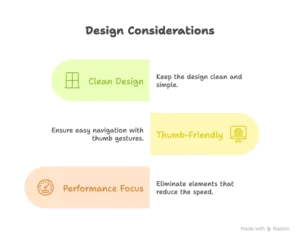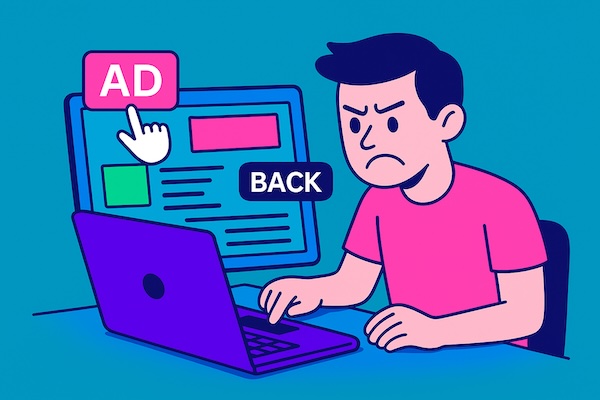So you’re running paid ads. Nice one! But if your landing page is half-baked, you might as well be burning £20 notes for fun.
Clicks mean Jack Diddly if nobody’s converting.
And truth is, most PPC campaigns don’t fail because of bad ads. They fail because the landing page doesn’t hold up.
In this guide, I’ll show you exactly what makes a high-converting PPC landing page – real-world advice you can act on today.
What Actually Makes a Killer PPC Landing Page?
Let’s be clear. A landing page isn’t there to look pretty.
It’s built for one job – turning visitors into leads.
Here’s what separates the good from the great:
1. Message Match
If someone clicks an ad that says “Luxury Kitchen Renovations in Brighton”, your landing page needs to reflect that headline, those visuals, and that offer.
No mixed messages. No confusion. Just a seamless journey from ad to action.
Google’s watching too. The closer the match, the better your Quality Score – which means cheaper clicks and more visibility.
We dig into this more in our guide on how to create high-converting landing pages for Google Ads.

2. One Goal. One CTA.
This isn’t a homepage. It’s a purpose-built conversion path.
No nav bar. No distractions. No “learn more” side links that send users off on a detour.
Stick to one clear message and one action – repeated in slightly different ways for maximum impact:
- Book Your Free Consultation
- Start Your Quote
- Get Started Today
- See What’s Possible

3. Speed and Mobile First
In 9 out of 10 cases most of your ad traffic will come from mobile. If your page takes more than a couple of seconds to load or buttons are too small to tap, you’ve already lost the lead.
Use tools like our site speed checker to benchmark your performance. Make the layout clean and thumb-friendly. Strip out anything that slows it down.
For more tips on speed and performance, head over to our post on why load time affects both SEO and user behaviour.
4. Trust Signals
People won’t convert unless they trust you.
Add proof. It could be:
- Google Review stars
- Client logos
- Checkatrade badges
- Industry accreditations
- One-liner testimonials
- Quick case study quotes
We shared examples tailored for local businesses in this practical SEO content guide for builders.
5. Clear Visual Hierarchy
Design isn’t just about looks. It’s about guiding attention.
Start with a bold, benefit-led headline. Use bullet points. Break text into clear sections. Use arrows, eye-line images, or shapes that point to the form or button.
Keep the fonts clean and readable. Use white space to let the content breathe. Don’t cram.
Why You Should Never Send PPC Traffic to a Generic Page
Still sending traffic to your homepage or general service page? That’s like inviting someone into a shop, then leaving them standing in the doorway with no one to help and no signs telling them where to go
Here’s why custom PPC landing pages are non-negotiable:
1. Control and Clarity
With a standalone page, you’re in charge. No menus. No footers. No distractions.
Just one path to action – like a focused sales pitch that leads straight to the point.
This is one of the reasons why Google Ads campaigns underperform when paired with generic pages.
2. Campaign-Specific Customisation
Different ad groups deserve different pages.
If you’re targeting Brighton, the page should mention Brighton. If it’s a B2B offer, use B2B language. If it’s a kitchen brand, show a kitchen — not a stock photo of someone on a headset.
Generic doesn’t convert. Relevance does.
3. A/B Testing Made Easy
Want to find out which CTA drives more leads? Which headline hooks better? Which layout gets more form fills?
That’s where testing comes in – and it’s much easier when you’re not fiddling with your main website.
We explained more in our post on common PPC mistakes and how to fix them.
4. Better Quality Scores and Lower CPC
Google rewards you when your ad, keywords, and landing page are tightly aligned.
- More impressions
- Cheaper clicks
- Higher ad ranks
It’s not about spending more – it’s about spending smarter.
5. Easier Tracking and Analytics
Want to set up UTM tags? Track button clicks? View heatmaps of where users drop off?
Landing pages make it easier. You can assign specific goals and measure what really matters.
For a deep dive into how analytics is evolving, check out our breakdown of what’s new with GA4.
When It’s (Maybe) Okay to Use a Standard Page
Not every campaign needs a fresh page from scratch. Sometimes you can work with what you’ve got — if you’re careful.
Here’s when it’s passable:
- You’re running a retargeting ad to warm traffic
- The product or service page is already conversion-optimised
- It’s a small, temporary campaign with limited budget
If you do reuse a page, clone it. Strip it down. Treat it like a landing page — not a brochure.
Real Talk: Focused Pages Convert
Let’s look at a real example.
One of our clients – a fast-growing sports tech firm – was sending ad traffic to a generic product page. It looked alright, but it didn’t convert.
We built a lean landing page just for PPC. No menu. No mess. Just a sharp headline, clear value prop, and form up top. As the user scrolled, CTAs stayed visible — each worded for a different mindset:
- Speak to Our Team Today
- Find Out What’s Right for You
- Let’s Make a Plan
- Book Your Demo Now
- Get Expert Advice Fast
- Start Your Free Assessment
Same offer. Better delivery. The result?
They increased their conversion rate by 5x.
Quick Checklist: Is Your Page Built to Convert?
- Does your headline mirror your ad copy?
- Is there just one CTA and one goal?
- Have you added real trust signals?
- Is the page fast and mobile-friendly?
- Can you easily A/B test different elements?
If not, you’re leaving leads on the table.
Want a Second Pair of Eyes?
Sometimes all it takes is a quick outside look to spot what’s not working.
Book a free website review.
We’ll tell you what’s solid and what’s silently killing your conversions.


